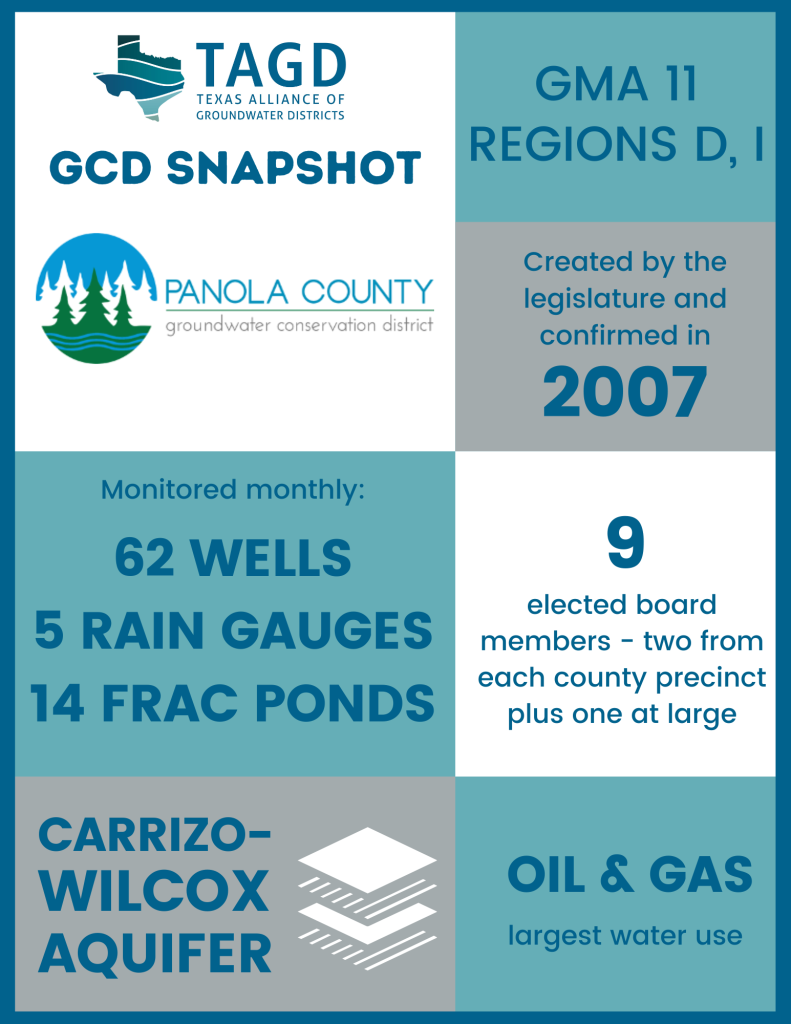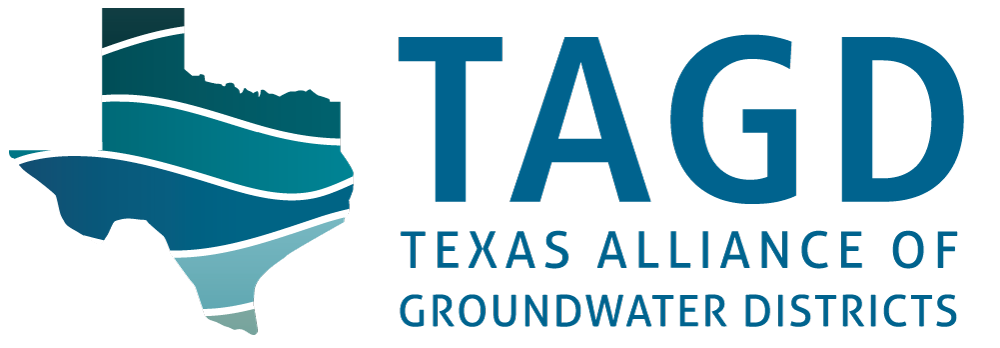Panola County GCD
Published November 14, 2022 by Julia Stanford
 Nestled deep in the Piney Woods, Panola County has a rich history and tight-knit culture that exemplifies rural East Texas. The county overlies a massive natural gas field that drove development and population growth in the area after World War II. Carthage, the county seat and home to Panola County GCD, has appeared on several lists of the best small towns in America and has charming attractions like a revitalized town square and even the Texas County Music Hall of Fame – it doesn’t get much more Texan than that! The Sabine River runs through this part of East Texas, but it does not serve as a substantial water source in Panola County and instead continues downstream where flows are impounded to form Toledo Bend Reservoir.
Nestled deep in the Piney Woods, Panola County has a rich history and tight-knit culture that exemplifies rural East Texas. The county overlies a massive natural gas field that drove development and population growth in the area after World War II. Carthage, the county seat and home to Panola County GCD, has appeared on several lists of the best small towns in America and has charming attractions like a revitalized town square and even the Texas County Music Hall of Fame – it doesn’t get much more Texan than that! The Sabine River runs through this part of East Texas, but it does not serve as a substantial water source in Panola County and instead continues downstream where flows are impounded to form Toledo Bend Reservoir.
Panola County GCD was created in 2007 to protect local interests and ensure water availability well into the future. The district permits groundwater production from the Carrizo-Wilcox aquifer, which serves as the main water source in the county. Some groundwater management tools used by Panola County GCD include production limits, metering requirements on all permitted wells, and well spacing standards.
Water Quality
The largest groundwater use in Panola County GCD is for holding ponds for the water used in hydraulic fracturing to extract oil and gas from deep underground, known as “frac ponds.” The county is the second most productive in the state for natural gas and has thousands of wells dotting the landscape. Panola County GCD has developed a water quality program to establish baseline measurements throughout the county and monitor any changes.
In 2019 the district contracted with INTERA to conduct a baseline water quality assessment, using data from the Texas Water Development Board and previous groundwater research in the area. This study found that the quality of the groundwater in Panola County GCD is suitable overall for most uses, with only one constituent (fluoride) appearing above the federally-established maximum contaminant level in two samples out of 251 samples. Some wells in the western half of the county have total dissolved solids measurements that exceed the secondary maximum contaminant level guidelines that may impact the taste, but not the safety, of the water.
The district followed up on that study in 2021 with in-house analysis on water samples from 123 wells. This study was made possible by a generous donation from Chevron, a permit holder in the county. Panola County GCD now proudly has baseline water quality information on every grid in the county. The district also offers water quality analysis to registered well owners for free. Some permit holders are required to submit quarterly water quality tests as a condition of their permit.
Panola County GCD hosts an interactive public map with locations and data for registered wells, monitor wells, water quality information, artesian wells, and more. Click the image to the left to explore the map.
Community Outreach
Even if they’re not applying for a permit or bringing in water samples to be tested, it’s likely that any Panola County resident has had some sort of interaction with Panola County GCD through its robust community outreach efforts. General Manager Teresa Griffin recognizes that public awareness is one of the biggest challenges facing groundwater management. “I want people to know that we fully protect their rights to the water under their land, and we are not here to usurp that right in any way,” says Griffin. To help spread the word about the district and what they do, the district’s four full-time staff members work together to educate the public at every opportunity.
One way the district provides this information is through guest columns in the local newspaper, the Panola Watchman. Recent topics have included water well winterization, frac ponds, abandoned wells, and joint planning. This regular coverage ensures that the public has some idea of the groundwater conservation district and what it does, and also keeps them informed on water issues or concerns specific to their area. The district also runs advertisements and educational articles in the Panola Crossroads, a free community magazine.




Photo 1 and 2: Panola County GCD Office Manager Ashley Whitaker and Field Technician Eric Solis spoke at the Sammy Brown Library about groundwater and surface water. Photo 3: Students at a 4H club meeting creating an edible model of soil and rock layers.
The district has cultivated a reputation as the go-to source for water education for all ages. Ashley Whitaker manages the district’s office operations as well as education programs. She stays busy, aiming for 1-2 educational presentations per quarter. The public library hosts a summer reading camp for children of all ages, and the Panola County GCD presentations are always a highlight. Ashley finds a way to relate the camp’s theme to the work that the district does, and last summer she even took participants on a “Magic School Bus” themed journey through the water cycle! Ashley and the district’s two field technicians also serve as guest presenters for local 4-H and FFA groups, in addition to providing requested programs to public school classes.
Panola County residents know that their local groundwater conservation district is managing and protecting their shared groundwater resources, and that they’ll always be kept informed through the district’s community outreach. To learn more about Panola County GCD, visit www.pcgcd.org.

